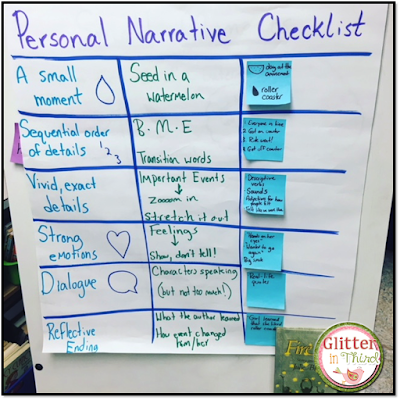Join the VIP Teacher Club!
Personal narratives are one of my favorite writing units to teach! My unit is an example of my Pinterest addiction. I take bits and pieces of great ideas that I find on Pinterest for my personal narrative unit. There are so many brilliant anchor charts that help out on Pinterest, I love meshing different teachers’ ideas together to find something that works best for my teaching style, my students and our classroom! We do not have a set writing curriculum at my school, so I love spending time finding ideas online to create the unit that fits my own personal teaching style and interests best.
A personal narrative is a story that is a “snapshot in time.” It focuses on a real-life event. However, it isn’t about an entire day in the life of a kid. I borrow an idea that I hear is originally from Lucy Calkins’ personal narrative unit with the idea of “small moments.” To put a “small moment” in perspective for kids, we discuss the difference between a watermelon and a watermelon seed. This is a terrific visual and understanding for kids who may otherwise not see the difference between their entire Tuesday, and the “small moment” of their days.
READ ALOUDS
I always incorporate read alouds into my writing units. What better way to learn and practice writing than to hear a variety of fabulous authors?
What I love about each of the read alouds that I choose for this unit is that they are SHORT. Unfortunately, we do not have the best schedule this year and do not have much writing time. I have so much writing block envy toward those teachers who get a full hour a day! As much as I’d love to use more Eve Bunting or Patricia Polacco books for this unit, I simply do not have half an hour to devote to the read aloud. The ones I chose are short, great examples of a personal narrative, and get the point across quickly.
Below, I will walk you through what the unit looks like in my classroom with my group of gifted third-graders.
DAY 1
Topic: Personal narrative elements
Read aloud: Roller Coaster by Marla Frazee

I hate making anchor charts. I love how they look and how the kids utilize them, but my handwriting resembles that of a 7-year-old boy. I have never been one who has good handwriting, and my hand always starts hurting when I write. Since I detest making anchor charts and am clearly a wimp about my hand, I use sticky notes with each read aloud so that I don’t ruin the whole anchor chart if I make a mistake!
After the chart is filled out, we finish the lesson off with a Turn-&-Talk. Basically, the kids pivot in their square spots to look at the person next to them. I say “Turn-&-Talk to your shoulder partner. What are some small moments that you could write about?” They discuss for about three minutes, then I call their attention up front. We share out some of their great ideas that they brainstormed.
I tell students that tomorrow we will learn more about how to make our own “small moments,” and practice brainstorming as well. Although no writing occurs today, the seeds have been planted in the students’ minds regarding what they will be writing about in the next few weeks.
DAY 2
Topic: Personal narrative “small moments”
Read aloud: A Chair for My Mother by Vera Williams
After our read aloud, we fill out the sticky notes for yesterday’s anchor chart on personal narrative elements, using a different color than the previous day to avoid confusion.
Next, we create an anchor chart about what a “small moment” truly is. We compare a watermelon vs a watermelon seed. For example:
WATERMELON WATERMELON SEED
going to the beach –> getting dunked by a big wave
my 7th birthday party –> eating a slice of cake
a soccer game –> scoring the winning goal
The kids “Turn-&-Talk” with their neighbor again about a small moment that they are thinking of writing. Then we share out. It is so much fun to watch the students’ excitement for their small moments and other students’ small moments!
Next, the kids return to their seats. In their writer’s notebook, they draw a small circle in the middle of the page. This is their “small moment.” Around the circle, they brainstorm everything they can think of about that small moment. What they heard, tasted, smelled, felt, and saw. I take about 15 minutes for this. Not all the kids are finished, but we will take more time the next day. At least with my group of third-graders, they have difficulty with the brainstorming portion of writing. After five minutes I start getting kids raising their hands with the usual “I’m done.” Keeping the brainstorming portion on the shorter side makes it easier for me to say “keep going!” without getting the writing burnout from many of my reluctant writers.
Afterwards, we return to the carpet with our writer’s notebooks. Each student shares their small moment and one thing that they put around their small moment. We do not make any comments or questions as we go around the circle. At the end, I ask which “small moment” from another student stuck out in their minds.
DAY 3 (during literacy stations)
Topic: Strong leads
I do this topic in small groups. I think that strong leads can be a hard topic for kids, and I think the more teacher guidance the better. I do these during my literacy stations (the kids are in groups of six students each).
I go over the anchor chart I created with the kids (again, inspired directly from Pinterest!), then they pick one type of strong lead that they want to try out for their small moment. This is the first line in their personal narrative. As they finish, I check them and give them ideas to improve or to make stronger. I am always blown away by what they come up with – some of them sound like professional authors!
DAY 3 (during writing)
Topic: Sensory details
Read aloud: Fireflies by Julia Brinckloe
First, we read aloud our book of the day and fill out the personal narrative element chart.
Next, we fill out an anchor chart that I created the morning of. We discuss what a sensory detail is – which uses the five senses (touch, hear, smell, taste, see).
The students go back to their seat and we do a “Write It Out.” For three minutes, I give them a topic and they write as much as they can using the topic. I tell them spelling and punctuation don’t matter – just write! The topic I give them for sensory details is, “describe your favorite dessert and a time that you ate it.” Afterwards, a couple of kids will share theirs with the group. It is pretty spectacular what some of these kids write!
I send the kiddos back to their seats to start their drafts. I remind them to start their personal narrative with the strong lead that they created earlier in the day. I also tell them to put themselves in their own shoes on the day of the small moment. Think of EVERYTHING that happened around you! Make the reader believe that they are truly there in that moment with you. We draft for about 15 minutes before getting into share.
Sitting in a circle, the kids find one line that shows sensory details that they want to share with the class. We go around in a circle and each student reads one line. At the end, I ask, “who read a line that makes you want to hear more about their story? What did they say?”
DAY 5-7
Topic: Drafting
Read aloud: Knuffle Bunny by Mo Williems
We read Knuffle Bunny together and fill out the personal narrative element anchor chart with Post-It notes. This gets the kids in the right direction for continuing their personal narrative drafts!
I send the kids back to their seats, and we continue the drafting process. I always tell my kids to skip lines, which makes it much easier for the revising and editing portion of the writing process.
During drafting, the kids pick one line each day that they want to read to the class. My kiddos love hearing work from their peers! I always ask at the end, “who read a line that makes you want to hear more about the story?” This gets the kids motivated to do the best job that they can with their writing!
DAY 6-end (this is flexible, depending on where the kids are at)
Topic: Revising, and final
For revising/editing, I pair kids up. I always do one high writer and a low writer. Each student gets a red pen. First they both read their stories aloud to one another. This provides plenty of “whoops!” moments for kids to revise what they wrote (they usually realized they forgot a period, need a comma, or that their story is missing a key detail!). Then they switch stories. They work on spelling, new paragraphs, punctuation, and adding stars if the story is missing important details.
When all is done, each student gets their final paper to write on. The top has a spot for an illustration. They are graded based on the overall message, organization, sensory details, planning, and grammar.
I LOVE this unit, and so do the kids! Since everything is broken down into small chunks, it isn’t overwhelming for the kids. I always see enormous improvement from our first writing piece to this one, they grow leaps and bounds. Try it out if you’re interested!
Do you do a personal narrative unit? What do you enjoy most about teaching it, and what mentor texts do you use?
(Glitter in Third is a participant in the Amazon Services LLC Associates Program, an affiliate advertising program designed to provide a means for sites to earn advertising feeds by advertising and linking to Amazon.).

Hey there, I’m Kelly! I I love helping teachers save time with technology and resources so they have more hours in the day to spend with family and friends. Take a look around to find new ideas that you can implement in your classroom today!
COPYRIGHT © 2024 · Terms and Conditions · Shipping Policy · Returns and Refund Policy